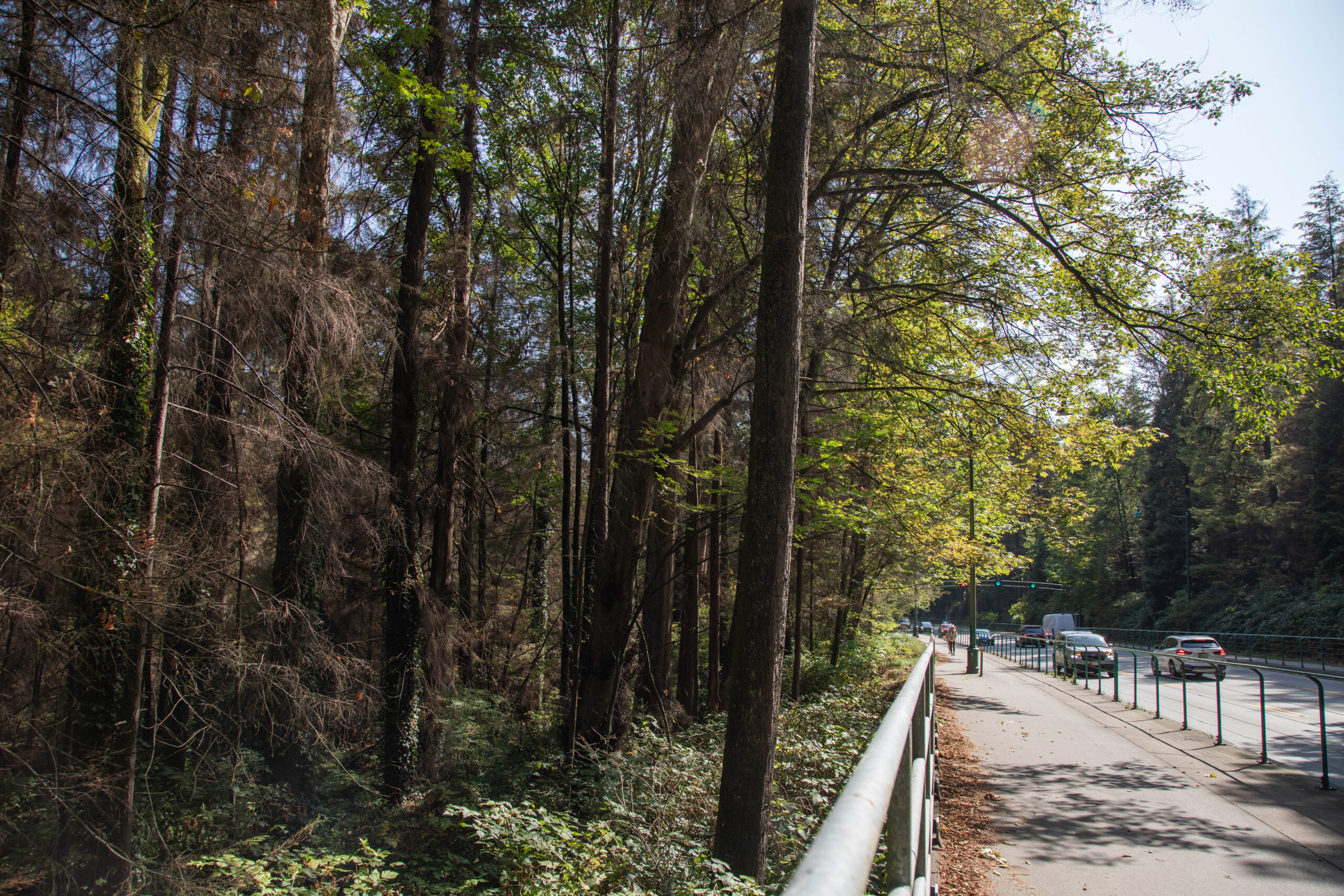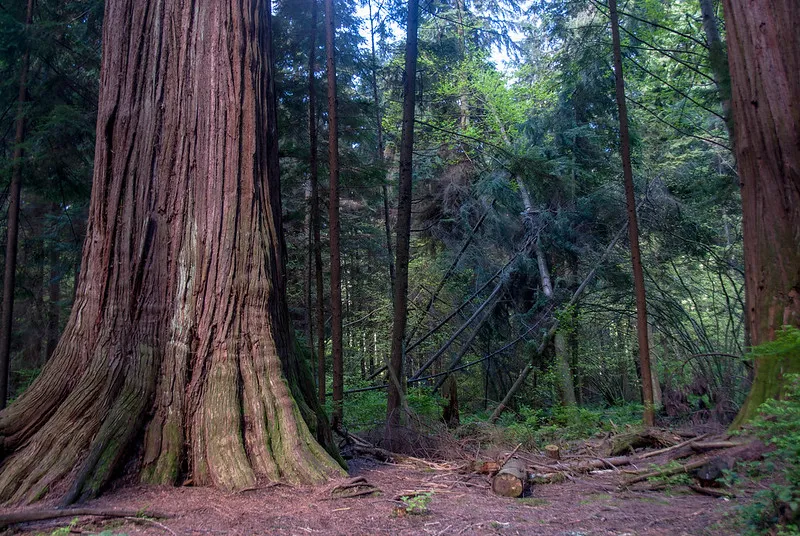The felling of any tree can provoke strong emotions. As the City of Vancouver continues to clear thousands of dead and dangerous trees from X̱wáýx̱way (Stanley Park), the Vancouver public’s response ranges from outrage to overt support.
Amidst the clamour of chainsaws and protestors, X̱wáýx̱way remains a gathering place for the xʷməθkʷəy̓əm, Skwxwú7mesh, and səlilwətaɬ (Musqueam, Squamish, and Tsleil-Waututh) First Nations. Ceremonies, cultural events, and political discussions have taken place on this site for more than 3,000 years, continuing even after the city destroyed the remaining village structures in 1887 to build the park road.
And yet these nations have little say over how the park is managed.
These days, Stanley Park is “a forest garden maintained by non-Indigenous people,” says Tʼuyʼtʼtanat Cease Wyss, a Skwxwú7mesh, Stó꞉lō, Hawaiian, and Swiss ethnobotanist and interdisciplinary artist in residence in Stanley Park as part of the Vancouver Park Board’s Fieldhouse Activation Program.
“Stanley Park was neglected for 200 years. That’s the bottom line,” Wyss says. “If you’ve been planting in a way that is companion planting, and you keep down weeds, and you keep out invasives, you’re tending to it—it stays healthy. But if you neglect it, the things that take over will take over fast.”
Wyss continues, “When you look at the figures of 160,000 hemlocks on a site that there should have been maybe three to 4,000 hemlocks, it’s an issue.… We’re literally cleaning out an indigenous plant that became an invasive species due to the poor forestry practices 200 years ago.”
Related stories
- Rethinking Stanley Park
- Volunteers in Vancouver Are Protecting Stanley Park From an Unlikely Threat
- Finding Stanley Park’s Mother Tree
Joe McLeod is the associate director of Urban Forestry and Specialty Parks at the City of Vancouver and is tasked with managing Stanley Park, keeping in mind public safety and the needs of stakeholders. He says reconciliation and consultation with First Nations are “definitely something we’re grappling with” at the city level.
Things have changed significantly over McLeod’s 14-year tenure at the city. When he started, they had “kind of carte blanche. You had a new site—create a new park.” In 2014, the city brought in an archaeologist, shifting away from the idea of terra nullius, an assertion that land was vacant and ownerless before colonization. Now the conversation has evolved to include both the past and, as McLeod says, “a better understanding” of future planting and ecology needs, and “aspirations” for things like edible landscapes and cultural uses when trees are removed.
McLeod says the city’s team has been engaging with the First Nations about the hemlock looper moth outbreak since July 2022. His team asked the nations about “their aspirations when it comes to restoration of these landscapes” and “provision of some of the wood that’s coming from Stanley Park.”
As a result of this consultation, the city has already planted more than 25,000 trees in the park. Most of those are Douglas fir and cedar, both native to the park. McLeod says the main piece of feedback was that the nations wanted to make sure that there was a good balance of native species not only adapted to future climate but also without overrepresenting hemlock.
“Hemlocks are actually supposed to be tiny trees,” Wyss says. “They shouldn’t get more than 20 feet high, because they can become dangerous. They’re one of the most dangerous trees in the forest. You can’t use it as firewood, because they spit in many directions. They crumble and spit, and one spark could ignite the whole forest.”
McLeod says that by the end of the spring, “We will have risk mitigated about 60 per cent of the forested area of the park, and that will have resulted in just over 45,000 trees being planted.”

Courtesy of the Vancouver Park Board.
Around 1,000 of those trees are western (Pacific) yew, which McLeod says was the main species the nations asked for. “Pacific yew is important culturally for all three nations,” McLeod says. He would have liked to have planted more but says, “It’s actually surprisingly hard to procure Pacific yew. There’s not a lot of nurseries that are propagating [it].”
Andy Ferguson, stewardship coordinator at the Stanley Park Ecology Society (SPES), also notes issues in procuring native species. He is part of a cross-organizational team that helps with replanting areas where dangerous trees are removed. And unlike in previous decades, Ferguson says SPES strives to incorporate traditional knowledge.
So far, though, he says it has been difficult for SPES to find an ethnobotanist or knowledge holder willing to work with the organization. He suggests this may be due to the small populations of once large local First Nations and the even smaller number of individuals with knowledge of ethnobotany.
McLeod touches on this issue of capacity too. “I think the level of engagement has differed between the nations just based on their capacity, but nonetheless, they’ve all taken time to come visit the park.”
Ferguson mentions another possible issue, acknowledging that “a lot of organizations are reaching out to knowledge holders for advice or to do a land acknowledgement but don’t offer proper compensation for their time and knowledge.” He says that SPES wants to do things differently, with meaningful engagement, not just to “get a good PR statement.”
In addition to bringing in a member of the Squamish Nation to do plant walks with SPES, he also refers to Held by the Land: A Guide to Indigenous Plants for Wellness, a book published in 2023 by Leigh Joseph, a Squamish ethnobotanist. Ferguson appreciates that, among other things, the book provides a list of “some of the culturally significant species we may want to prioritize in our restoration efforts.” This led to a rework of SPES’s planting plans. According to Ferguson, in 2023, SPES planted more than 1,900 plants in Stanley Park, representing 37 native species. These numbers are up from previous averages of 600 to 800 total plants and 10 to 20 species in previous planting seasons.
Incorporating more Indigenous ecological knowledge into SPES practices is already paying dividends, with what Ferguson calls a “massive increase in biodiversity” in recent years. SPES still uses previously approved species but plants fewer numbers of each and augments these with “culturally or medicinally significant species that grow in those same ecosystem types or grow in relation to those plants.”
Ferguson acknowledges there’s a long way to go in these efforts at reconciliation and that SPES is also reckoning with its own history. This includes, according to Wyss, SPES’s censorship of “three young Indigenous matriarchs [and artists] from the three nations,” when phrases were removed from a park mural against the wishes of their authors. She says that “for 10 years, they kept it silent.”
This was before Ferguson’s time at SPES, but he says that he and other staff members have “pushed the organization to recognize that how SPES acted was wrong and to officially apologize to the artists and others involved in the project. We are still working through steps to make amends to the artists and to slowly rebuild trust and build new relationships with them going forward. It will take time to rectify our past mistakes, but I’m hopeful that we are on a path towards achieving that.” Wyss adds, “We’re repairing that conversation. We’re repairing that relationship right now.
“It’s a lot to unpack, the settler colonialism mentality in this park,” she notes. “I have tried to understand the process that the Park Board is going through, and there’s just a lot of negative reaction from West Enders that have this nostalgia about these hemlocks that is a little bit overbearing, overwhelming,” she says.
Wyss was not involved in the latest consultations with the city and isn’t aware of any ethnobotanists who were. She says she hopes that “the MST Corporation is representing all of our voices [as Indigenous people]. But it doesn’t mean we know. It’s like, nobody knows what really goes on in city hall.” She adds, “We put people there that we trust. We hope they’ll talk to us. We hope the city will talk to them.”
Aside from figuring out how to work together, controlling invasive species is one of the biggest challenges facing the City of Vancouver, SPES, and First Nations in managing Stanley Park. “When I’m walking through certain areas, and I see holly and laurel and knotweed and bamboo, for instance, popping up, or English ivy, those are just all signs of colonization,” McLeod says.
Ferguson suggests plans are afoot to update the Invasive Species Management Strategy for Metro Vancouver, published in 2014 by the Invasive Species Council of Metro Vancouver, though with so many stakeholders involved, the process is lengthy and complex. McLeod says the city is finalizing its own new invasives plan too.
“We have a choice to make,” McLeod says. “Stanley Park can look very different in 50 years, one way or the other, right? It could be dominated by invasives with huge areas where we are actually not even necessarily seeing forest, because trees aren’t able to propagate and germinate and grow into multiple stages of development. Or we can actually see a healthy ecosystem that’s somewhat resembling of a coastal western hemlock ecosystem.”
Wyss describes herself as a “vessel” to connect the past and present “towards the future.” She says, “I’m slowly becoming not the expert, and I’m okay with that, because I’m seeing my daughter and her children growing up with ethnobotany, with language, and with our culture, our songs, our stories, and connecting all of those things.” For Wyss, “the real power is in our young people, in our communities. They’re the ones that have reached the true level of decolonization. My mother didn’t. I didn’t. I’m almost there. I’m trying.”
Young people, she says, “are truly decolonizing their practices, their lives, and the world, you know, for the next generations.”
Read more community stories.









